ABSTRACT
“Marriage should be between a spouse and a spouse, not a gender and a gender.”
- Hendrik Hertzberg
Acceptance, recognition and status have surely been battle stages for the LGBTQ+(1) Community which has been the epicenter of controversy for centuries. Although recent events, such as the amendment of IPC (2) Section 377 (3), have proven to be hopeful, the LGBTQ+ community in India is still largely deprived of their basic rights, the very denial of which is violating and unconstitutional, owing largely to the deep-rooted culture of misunderstanding and ignorance, dating back centuries.
Overcoming not only the complexities of self-acceptance, self-confidence and self-actualization but the hurdles of discrimination, stigma, societal isolation and misunderstandings, this is a community that has never put a full stop on progress, so why should the law? For an equally perseverant group, there must be in place, equally inclusive policies for acceptance, recognition and equality.
Although many topics can be discussed when talking about inclusive rights for the LGBTQ+ Community in India, such as adoption rights, anti-discrimination policies, co-habitual rights and so on, this article sheds light on the topic of same-sex marriages and the taboos and misunderstandings surrounding the same.
The concept of same-sex marriage is one that has been debated over for generations, with some claiming that it violates the norms and sacredness of marriage whilst others imply that it is immoral as it defies the laws of biology, but who decides the significance of these norms and laws, and what do they mean? Does same-sex marriage really defy the norms and sacredness of marriage? To what extend does biology determine the morality and meaning of marriage?
This article takes a comprehensive look at the concept of marriage and its true meaning, whilst also exploring various arguments surrounding the legality and morality of same-sex marriage including social, cultural, biological and religious barriers that concern the same, in addition to emphasizing the need for progressive interpretations of marriage and parenting.
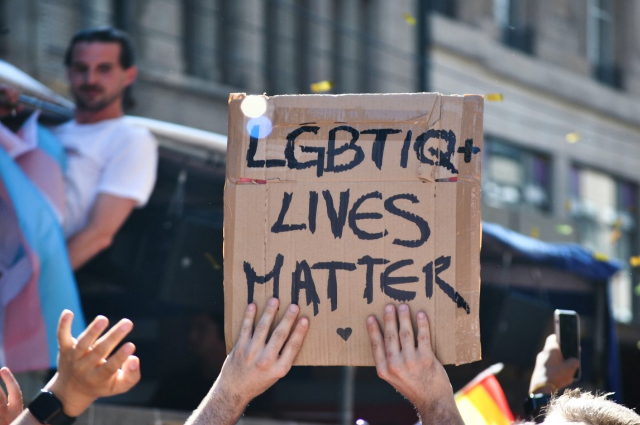
GLOSSARY OF TERMS
- LGBTQ+: Lesbian, Gay, Bisexual, Transgender, Queer + (an umbrella term).
- IPC: Indian Penal Code, 1860.
- Dharma: Dharma signifies behaviors that are in accordance with the order that makes life and the universe possible and includes duties, rights, laws, conduct, virtues and the ‘right way of living’.(4)
- Straight: A colloquial term for heterosexual.
- Homophobic: having or showing a dislike of or prejudice against homosexual people.(5)
- UCC: Uniform Civil Code.
INTRODUCTION
Marriage’ is a term that cannot be limited to a single definition, as that would do great injustice to its various contributing factors; religion, social norms, culture, law, biology etc. Instead, it must be defined under the context of such factors as the interpretation of marriage varies between countries, cultures and religions.
Legal Definition:
In the legal sense, marriage is stated as “a legally recognized union of a man and woman as husband and wife”(6) and in some cases where same-sex marriages have been recognized, the words ‘man’ and ‘woman’ have been substituted with either ‘partners’ or ‘spouse’(7). Marriage gives rise to certain social and legal obligations, which is what differentiates it from other quasi-marital relationships.
Religious Definition:
In some countries, marriage is an institution governed by religion. Marriage in Hinduism is not just a union or a contract between a man and a woman, it ties two souls together in a sacred affair that stretches beyond one era and may continue up to seven births.(8) It upholds marriage as a sacred relationship meant for the persistence of family, performance of religious duties, sexual pleasure and Dharma.(9) However, the modern-day concept of Hindu marriage regards ‘life-long companionship’ as the primary aim of marriage and not Dharma.
Conforming to Christianity, marriage, or holy monogamy, is grateful as a divinely endowed (10), lifelong, monogamous union between a man and a woman. It is viewed as the purpose of God, at the heart of which lies companionship, intimacy and child bearing. The biblical picture paints the relationship between a husband and wife as that of Christ and the Church. (11), (12)
In Islam, marriages are of a contractual nature, placing emphasis on an offer, acceptance and consideration in the presence of a competent witness. This contract, between a man and a woman, is an essential part of a valid marriage and outlines the obligations and rights of the bride and groom. Islam pictures marriage to be a “solemn covenant” (13) and considers marriage as a deed dear to God (14) along with a protection of one’s faith (15), (16) whether a sacrament or a contract, marriage, above sexual satisfaction, is commonly considered to be the joining of a man and a woman for the procreation of children and the fulfillment of divine duties.
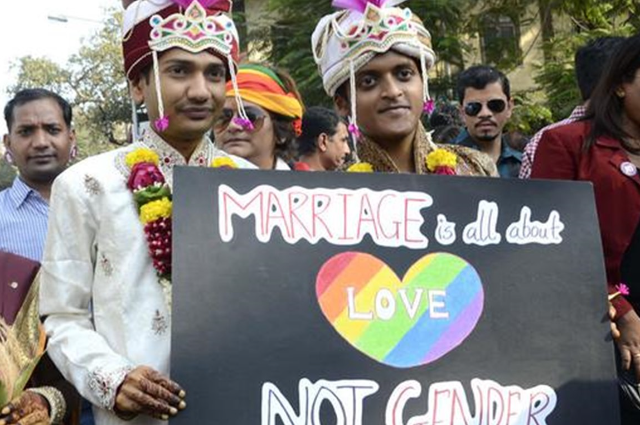
Social Definition:
In many societies, marriage is regarded as the basis of a family life, which is why marriages are socially welcomed and couples are expected to produce children almost immediately. This is also a key factor surrounding the stigma around children born out of wedlock or the concept of same-sex marriage. Hence, socially, the view of marriage is concerned with companionship, the beginning of a superior bond and the foundation of a family life.
Biological Definition:
Biologically, marriage entices the union of a man and a woman to be the father and mother of any children they may have as a result of such union. It is based on the anthropological fact that since men and women are biologically different yet complementary, the process of reproduction can only occur within opposite sexes. In most societies and cultures, the concept of ‘carrying forward the generation’ is essential in marriages and so in relation to this biological truth, marriage is viewed as the union between opposite sexes.
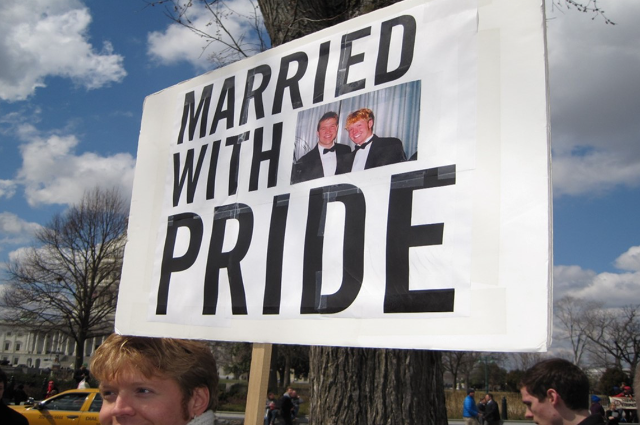
THE CRUX
The ideals and sacredness of marriage is one that should never be smeared, but neither should the provisions of marriage laws be in contrast to it.
Same-sex marriage has been an epicenter for many controversies over the years, the very idea of which triggers society to ‘protect their culture and beliefs’. Common arguments against same-sex marriage involve the notion that ‘marriage has always been between men and women’, ‘the inability of same-sex couples to procreate independently’ and the stigma that ‘homosexuality is unnatural and immoral’.
However, when exploring these arguments, the first flaw arises in the fact that there is no clear cut definition of what marriage truly is. As discussed, the concept of marriage is one that has different facets, so who is to say that a marriage outside of heterosexual norms is not a marriage at all?
Most arguments against same-sex marriages are flawed, in the sense that similar concepts within heterosexual relationships are accepted or at least less stigmatized. Many couples today have children out of wedlock and resort to early fulfillment of sexual desires and co-habitation, far before they are tied down by marriage or in numerous circumstances, the pair never makes it till marriage. How does this uphold the sacredness of marriage? In 2018, the Supreme Court of India ruled that “an adult couple has the right to live together without marriage”, upholding live-in relationships out of wedlock as being legally recognized. (17), (18)
Biologically, marriage is for the purpose of procreation and since same-sex couples cannot reproduce independently, their marriage becomes ‘purposeless’. However infertile men and women can still marry legally despite violating the biological definition of marriage. One does not need to conceive a child to raise it and one cannot effectively raise a child simply because they conceived it.
Marriage is also about parental duties and family life. However in 2011, there were around 20 million orphans in India alone (19), (20). The legalization of same-sex marriages and adoption will help bring homes to these children and the argument that the children raised by same-sex parents will ‘turn out to be gay’ is as flawed as stating that all children raised by heterosexual couples turn out to be ‘straight’ (21), (22).
Marriage has, since its inception, evolved with the times. The Anglo-Saxons viewed marriage as a tool to establish diplomatic relationships (23) whereas Louis XVI and Marie Antoinette’s marriage was for strengthening an alliance (24). The very nature of marriage is its ability to adapt and evolve with society (25) hence, denying same-sex marriages based on age-old traditions contrasts the very nature of marriage itself.
Furthermore, India’s homophobic (26) mob perceives homosexuality as a product of western influence despite numerous accounts of its presence in ancient Indian history. (27), (28), (29), (30)
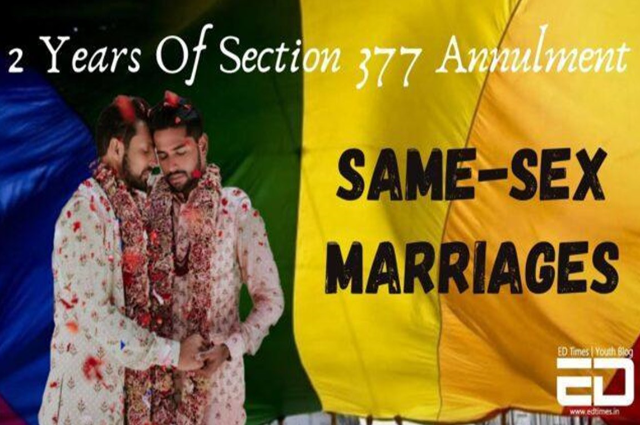
THE STATE OF AFFAIRS IN INDIA
Currently, India does not have a unified marriage law and is instead determined based on religion and culture (31). Neither of these acts expressly define marriage as between opposite sexes nor do they prohibit the same (32). The only state in India to have a unified marriage law is Goa but it has been expressly defined that marriage is between opposite sexes. In a country where inter-caste marriages still face wrath despite being legally accepted, the legalization and social acceptance of same-sex marriages might be a challenge, but not an impossible one (33).
In 2020, two men filed a suit in the Kerala High Court arguing that the prohibition of their marriage violates numerous constitutional provisions (34), (35), (36).
In 2017, a group of citizens proposed a draft Uniform Civil Code that would legalize same-sex marriages in India (37). The draft UCC (38) defines marriage as “the legal union…of a man with a woman, a man with another man, a woman with another woman, a transgender with another transgender or a transgender with a male or a female.” (39), (40) In this draft, any kind of gender-based discrimination for marriage, adoption, custody of children or inheritance is ruled out (41). If such a provision is adopted, same-sex marriages take a landmark leap forth in terms of recognition and rights
Lawyers Menaka Guruswamy and Arundhati Katju, the faces of the historic Section 377 verdict, revealed that their next step would be to legalize same-sex marriages in India (42), a step that would take LGBTQ+ rights in India to a whole new level not only legally but also socially.
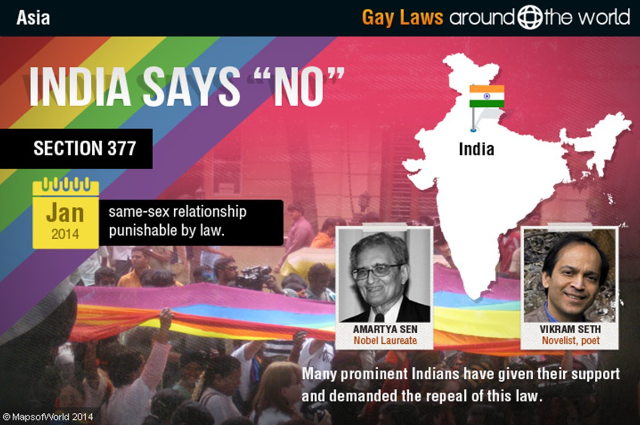
CONCLUSION
The LGBTQ+ community has, for generations, struggled to attain the same rights as a dignified individual in society and the world has had its fair share in letting them down, but no more should it to do so.
If marriage is a bond between two that extends beyond one lifetime, why is gender or sexuality given the power to determine this ‘one-ness’? If marriage is a bond above all others, why fail to recognize all instances of such bonds? To quote Justice Kennedy (43), “It would misapprehend these men and women to say they contempt the idea of marriage… they do admire it, admire it so deeply that they seek to find its fulfillment for themselves.” (44)
The recognition of same-sex marriages is one that is hopeful in India, for it is a right to a love, and isn’t love is an expression? (45)
“We are not a nation that recognizes girlfriends or boyfriends or dating, we’re a nation that sanctifies one kind of relationship and that is marriage”
- Menaka Guruswamy (46)
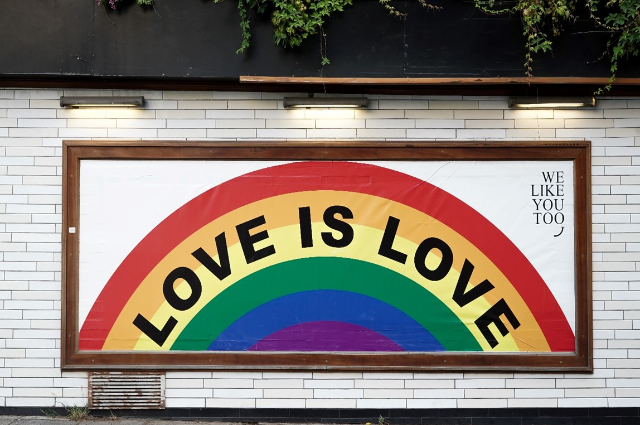
END NOTES:
- Point 1, Glossary of Terms
- Point 2, Glossary of Terms
- Section 377: Unnatural Offences; voluntary carnal intercourse against the order of nature
- Dharma, Wikipedia
- Definitions from Oxford Languages
- Marriage: The Legally or Formally Recognized Union of a Man and a Woman, CRAM (2016)
- Example: Canadian Civil Marriage Act, 2005
- Jayaram V, Hindu Marriages Purpose and Significance, HinduWebsite
- Point 3, Glossary of Terms
- Matthew 19:5-6, The Bible Hub
- Challies (2012), A Picture-Perfect Marriage
- Ephesians 5:23-25
- Qur’an 4:21
- “There is no foundation built in Islam dearer to God than marriage” (Majlisi 1403, 100:222)
- “When a man marries, he has protected half of his religion” (Hurr al-‘Amili 1412 AH, 14:5)
- Mansoureh Zarean & Khadijeh Barzegar, Marriage in Islam, Christianity and Judaism (2016)
- Adv. Sanjeev Sirohi, Right of Adult Couple to Live Together without Marriage: SC, Law Articles, Legal Services India (2018)
- Nandkumar & Anr v. The State of Kerala & Ors (2018) CRIMINAL APPEAL NO. 597 OF 2018
- India now home to 20 million orpahans, study finds, SOS Children’s Villages Canada
- Chetan Chauhan, About 20m kids in India oprhans: study, Hindustan Times
- Point 4, Glossary of Terms
- Tumblr
- Lauren Everitt, Ten Key Moments in History of Marriage, BBC News Magazine (2012)
- This Day in History (May 16), History.com
- Read More: The Origins of Marriage, The Week Staff, TheWeek.com
- Point 5, Glossary of Terms
- Sanjana Ray, Indian Culture Does Recognize Homosexuality, Let us Count the Ways, TheQuint (2018)
- Vikas Pandey, Why Legalising gay sex in India is not a Western Idea, BBC News (2018)
- Homosexuality in Ancient India: 10 instances, IndiaToday (2018)
- Devdutt Pattanaik, Did Homosexuality exist in Ancient India?, devdutt.com (2009)
- Indian Christian Marriage Act, 1872, Hindu Marriage Act, 1955, Parsi Marriage and Divorce Act, 1936, Muslim Personal Law (Sharia) Application Act, 1937.
- Recognition of Same-Sex Unions in India, Wikipedia
- Marriage Project: Lawyer Couple Who Fought against Section 377 now want to legalize gay weddings, Buzz Staff, News18
- Recognition of Same-Sex Unions in India, Wikipedia
- Gay couple moves Kerala high court to register marriage, Times of India (January 2020)
- Parvathi Benu, Meet the gay couple that asked the Kerala High Court to legalize gay marriage, Edex Live (2020)
- LGBT Rights in India, Wikipedia
- Point 6, Glossary of Terms
- LGBT Rights in India, Wikipedia
- Anurag Dey, A new UCC for new India, CatchNews (2017)
- Anurag Dey, A new UCC for new India, CatchNews (2017)
- Lawyers behind scrapping of Section 377 now step forward to legalize same-gender marriage, Jagran English (2020)
- Obergfell v. Hodges (2015) 576 U.S. 644 (2015)
- John Schwartz, Highlights From the Supreme Court Decision on Same-Sex Marriage, New York Times (2015)
- Article 21, The Constitution of India (1950)
- 377 Lawyers bat for Same-Sex Marriage, Brut India (2020) [Source: The Oxford Union]
